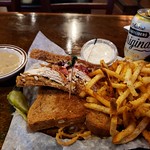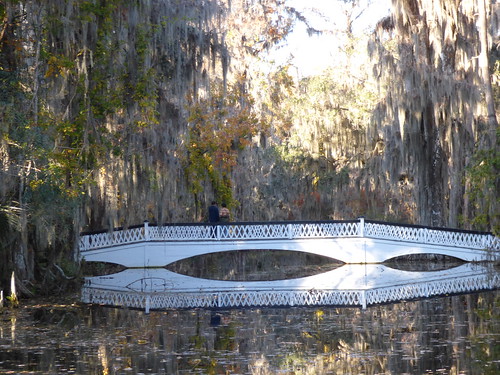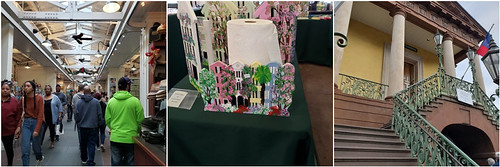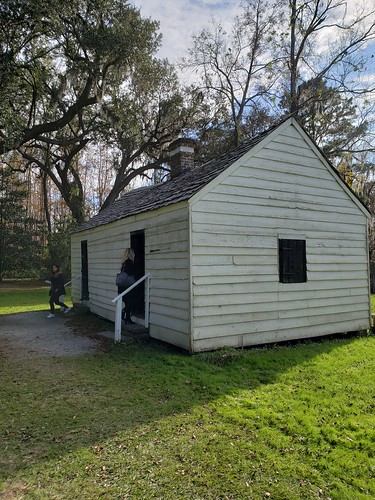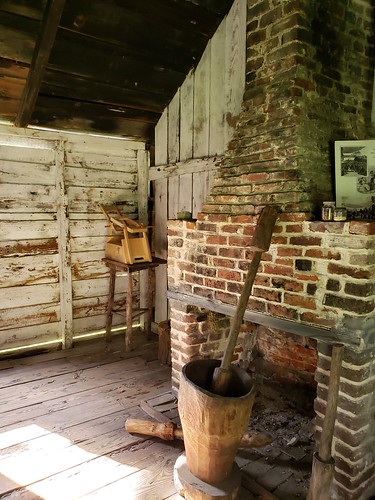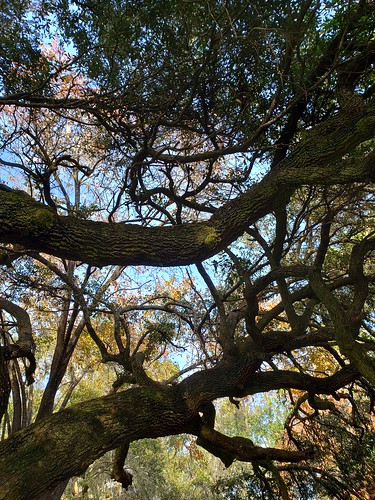December 31, 2019
December 30, 2019
#200 Low Country Cuisine
“The extraordinary mingling of the French, Spanish, African, and Caribbean cultures that took root here during the centuries of sometimes tumultuous history has left an imprint on the local cuisine, which incorporates traditional Low Country ingredients such as shrimp, oysters, rice, okra, field greens, and tomatoes.”
That translates to – lots of seafood stuff that I can’t eat. So, my take was more traditional southern than seafood, but this “thing” will definitely be revisited because I didn’t get to Magnolia which is specifically called out in 1000PTSBYD.
That translates to – lots of seafood stuff that I can’t eat. So, my take was more traditional southern than seafood, but this “thing” will definitely be revisited because I didn’t get to Magnolia which is specifically called out in 1000PTSBYD.
December 28, 2019
#199 Heart of Charleston
“America’s most intact colonial city, sultry, and gracious Charleston seduces visitors with its languid mystery and European charm, its historic architecture and friendly residents, and lately its exciting arts and restaurant scene – heralds of the city’s new golden age.”
“Founded in 1670, Charleston took less than a century to become one of the richest cities in colonial America. The British laid much of it to waste during the Revolution, and just one century later the city became the symbol of Southern resistance [more accurately: treason] when the first shots of the Civil War were fired at Union-occupied Fort Sumter, which guards Charleston Harbor. Take a crash course in the city’s heritage with a visit to the Charleston Museum, the country’s oldest (founded in 1773), located in the Heart of the Historic District.”
Can’t visit Charleston without seeing the famous pineapple fountain.
I voluntarily went to the Charleston Market. It was….exactly like I thought it would be. Crowded, hot, and shopping.
I had a plan to visit several of the area’s plantations but was only able to see one. Magnolia Plantation. Magnolia is Charleston’s most visited plantation. It was founded in 1676 by the Drayton family and opened its gardens to visitors in 1870 making it the oldest public tourist site in the Low Country and the oldest public gardens in America.
They also host a Chinese Lantern Festival during December and that was set up when I visited the day after Thanksgiving.
I did two tours The Nature Tram and From Slavery to Freedom.
From Slavery to Freedom tours five historic structures that date back to 1850. The docent was really good he spoke about the rise of rice plantations and the dehumanization of slavery. One of the preserved cabins was actually inhabited by descendants of Magnolia’s enslaved people until the 1990s.
He talked about the brutal labor that was required and how slaves were seen as an investment, not people. To illustrate this he pointed across the road and told us the slaves were initially housed there, in simple adobe homes that were flat on the ground. Now, if you’ve ever been to the coastal south, you’ll know that all the homes are built on stilts…at least a foot high. This reduces the flooding and just general damp, the mosquitoes, etc.
This means it also reduces the likelihood that you’ll get sick and die from diseases associated with all of that. Plantation owners didn’t really care if their slaves died, at least initially. They were a disposable asset, cheap to replace. But once the import of slaves were banned, owners took (and I can’t emphasize this enough) THE MOST BASIC steps to minimally improve living conditions. They also participated in atrocities such as forced childbearing, since they now had to rely on the birth rate to maintain their enslaved populations.
So, after spending an hour entrenched in the atrocities of our forefathers, I took the nature tram. Again, really good guide, and this time we got to see alligators. We also got to see first-hand some of the damage that Hurricane Dorian did as it ripped along the coast felling trees and tearing everything up.
“Founded in 1670, Charleston took less than a century to become one of the richest cities in colonial America. The British laid much of it to waste during the Revolution, and just one century later the city became the symbol of Southern resistance [more accurately: treason] when the first shots of the Civil War were fired at Union-occupied Fort Sumter, which guards Charleston Harbor. Take a crash course in the city’s heritage with a visit to the Charleston Museum, the country’s oldest (founded in 1773), located in the Heart of the Historic District.”
Can’t visit Charleston without seeing the famous pineapple fountain.
I voluntarily went to the Charleston Market. It was….exactly like I thought it would be. Crowded, hot, and shopping.
I had a plan to visit several of the area’s plantations but was only able to see one. Magnolia Plantation. Magnolia is Charleston’s most visited plantation. It was founded in 1676 by the Drayton family and opened its gardens to visitors in 1870 making it the oldest public tourist site in the Low Country and the oldest public gardens in America.
They also host a Chinese Lantern Festival during December and that was set up when I visited the day after Thanksgiving.
I did two tours The Nature Tram and From Slavery to Freedom.
From Slavery to Freedom tours five historic structures that date back to 1850. The docent was really good he spoke about the rise of rice plantations and the dehumanization of slavery. One of the preserved cabins was actually inhabited by descendants of Magnolia’s enslaved people until the 1990s.
He talked about the brutal labor that was required and how slaves were seen as an investment, not people. To illustrate this he pointed across the road and told us the slaves were initially housed there, in simple adobe homes that were flat on the ground. Now, if you’ve ever been to the coastal south, you’ll know that all the homes are built on stilts…at least a foot high. This reduces the flooding and just general damp, the mosquitoes, etc.
This means it also reduces the likelihood that you’ll get sick and die from diseases associated with all of that. Plantation owners didn’t really care if their slaves died, at least initially. They were a disposable asset, cheap to replace. But once the import of slaves were banned, owners took (and I can’t emphasize this enough) THE MOST BASIC steps to minimally improve living conditions. They also participated in atrocities such as forced childbearing, since they now had to rely on the birth rate to maintain their enslaved populations.
So, after spending an hour entrenched in the atrocities of our forefathers, I took the nature tram. Again, really good guide, and this time we got to see alligators. We also got to see first-hand some of the damage that Hurricane Dorian did as it ripped along the coast felling trees and tearing everything up.
December 25, 2019
#198 The Outer Banks
“Some of the most unusual and beautiful beaches on America’s Atlantic coast can be found in North Carolina’s Outer Banks, a string of skinny barrier islands. The candy-striped Cape Hatteras Lighthouse is the most famous structure on the Outer Banks and the tallest of America’s lighthouses. Tricky winds and tides necessitated its construction, having sunk more than 650 ships.”

“Sanderling Inn, which sits just north of the whimsically monikered town of Duck …[is] known as the Outer Bank’s most luxurious refuge, the inn is also ecosensitive. The inn’s restaurant, adjacent to the main house in a restored 1899 United States Lifesaving Station [is] famous for its excellent menu, themed to the sea, and with a Southern slant.”

I had scheduled three weeks in an Airbnb in OBX and was really looking forward to some rest and relaxation, cleaning out my car, and resetting after nearly 6 weeks of weekly moves. It ended up being a different kind of adventure. I ended up with a dental emergency that resulted in my visiting a dentist, an endodontist, and finally an oral surgeon. The oral surgery, while not serious, was not fun, and I spent my first weekend there recovering from that.
The second weekend, I was planning to drive all the way down to Cape Hatteras (Ocracoke Islands is still off-limits after damage suffered in Hurricane Dorian) and then back up to Duck and the Sanderling Inn, but a nor’Easter spun up and my host advised me that driving down to Hatteras might result in me being stranded. I ended up driving to Bodie Lighthouse and then one of the local beaches. It was so cold and windy, and the ocean was already very, angry. I opened my car door at the beach and suddenly, half the beach was in my car and stuck to all my clothes.
My host was right, the only road that runs over the bridge and down to Hatteras was closed. And it was closed for several days. On the bridge they worry about ocean overwash...basically waves crashing over and onto the road and whatever might be on it. Terrifying. And on certain sections, the road is lined with super tall sand dunes. In a storm like this, the wind and ocean overwash blow/push all the sand from the ocean side right onto the road. By the time I drove down to Hatteras a week and a half after the storm, there were still places that were sand-packed.

I also thought this would be a great place to get my oil changed and my tired balanced/rotated. I’d been feeling a lot of vibration in the last couple of weeks, but when they put my car on the lift to work on the tires we all discovered that the rear tires had no tread left. Like, none. Like, I don’t even want to drive this car back to your Airbnb, gone. I’m still so grateful that I didn’t get a flat or have a tire blow out on me. I’ve driven in some pretty remote areas and gone a really long time without seeing another person, so I’m so grateful that I made it somewhere I’d ben staying for several weeks and had the time to get everything done. So, surprise new back tires and shocks.

Positives:
- I really did get to rest up while there. I had a fantastic place to stay, and the host was so nice. I’d mentioned in passing that I’d be holed up all weekend after my dental surgery, and he messaged me Sunday to make sure I was all right and ask if I needed anything because he was headed to the store. The both gave me good local advice, and made sure I didn’t get myself stranded in the wilderness.
- I got my car detailed. It looked amazing! (for about 5 minutes)
- I found the best white pizza in the world. Seriously, I ate at Barefoot Bernie’s 4 or 5 times, and always got the white pizza. They do a lot of seafood, and they took my allergy seriously, and tagged my plate to make sure it didn’t get contaminated. But seriously, it was delicious.
- I also had a bunch of good bbq. I was kind kind of limited in what I could eat, though, because my mouth was still all messed up.
- It really is a beautiful part of the country.
Subscribe to:
Comments (Atom)





